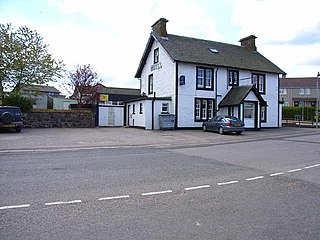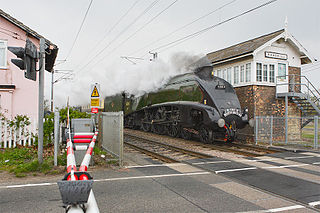
Seascale is a railway station on the Cumbrian Coast Line, which runs between Carlisle and Barrow-in-Furness. The station, situated 33+1⁄4 miles (54 km) north-west of Barrow-in-Furness, serves the village of Seascale in Cumbria. It is owned by Network Rail and managed by Northern Trains.
The Edinburgh and Glasgow Railway was authorised by Act of Parliament on 4 July 1838. It was opened to passenger traffic on 21 February 1842, between its Glasgow Queen Street railway station and Haymarket railway station in Edinburgh. Construction cost £1,200,000 for 46 miles (74 km). The intermediate stations were at Corstorphine, Gogar, Ratho, Winchburgh, Linlithgow, Polmont, Falkirk, Castlecary, Croy, Kirkintilloch and Bishopbriggs. There was a ticket platform at Cowlairs. The line was extended eastwards from Haymarket to North Bridge in 1846, and a joint station for connection with the North British Railway was opened on what is now Edinburgh Waverley railway station in 1847.
The Edinburgh–Bathgate line is a railway line in East Central Scotland. It is also known as the Bathgate branch and was originally operated by the Edinburgh and Bathgate Railway. Except for the short section at the original Bathgate terminus, the main line is still in use, with a frequent passenger train service operated by Abellio ScotRail.

Uphall railway station serves the village of Uphall Station and some areas of Livingston in West Lothian, Scotland. It is located on the North Clyde Line, 12½ miles (20 km) west of Edinburgh.

Stonehaven railway station serves the town of Stonehaven in Aberdeenshire, Scotland, United Kingdom. It is a calling point for most services going both north to Aberdeen and south to Edinburgh, with a small number of services to Glasgow. In addition, it is served by a regular stopping service between Montrose and Inverurie.
The Scottish Central Railway was formed in 1845 to link Perth and Stirling to Central Scotland, by building a railway line to join the Edinburgh and Glasgow Railway near Castlecary.

Drumlithie is a village in the northeast of Scotland in the area known as the Howe o' the Mearns. Situated seven miles south of Stonehaven in Aberdeenshire, it is affectionately known by locals as 'Skite', although the origin of this name remains disputed.
The Clydesdale Junction Railway company was formed to build a railway connecting Motherwell and Hamilton with Glasgow, in Scotland.

The Aberdeen Railway was a Scottish railway company which built a line from Aberdeen to Forfar and Arbroath, partly by leasing and upgrading an existing railway.
The Dundee and Perth Railway was a Scottish railway company. It opened its line in 1847 from Dundee to a temporary station at Barnhill and extended to Perth station in 1849. It hoped to link with other railways to reach Aberdeen and changed its name to the Dundee and Perth and Aberdeen Railway Junction Company, but this early attempt was frustrated, and for some years it failed to make a physical connection with other railways in Dundee.

Old Leake was a railway station on the East Lincolnshire Railway which served the village of Old Leake in Lincolnshire between 1848 and 1964. It originally opened as Hob Hole and was renamed three times within the first five years of opening. Withdrawal of passenger services took place in 1956, followed by goods facilities in 1964. The line through the station remains in use as the Poacher Line.

Astley was a railway station on the Liverpool and Manchester Railway on Chat Moss to the south of Astley village in what was then the county of Lancashire, England.
The Wilsontown, Morningside and Coltness Railway was a railway opened in 1845, primarily for mineral traffic, although a passenger service was run sporadically. The line ran from a junction with the Wishaw and Coltness Railway at Chapel, to Longridge, in South Central Scotland, and it was extended to Bathgate in 1850 after takeover by the Edinburgh and Glasgow Railway. It was built to open up further coal deposits and to connect the Wilsontown Ironworks, although it did not actually reach Wilsontown. In common with the other "coal railways" with which it connected, it adopted the track gauge of 4 ft 6 in, often referred to as Scotch gauge.

Ranskill railway station served the village of Ranskill, Nottinghamshire, England from 1849 to 1964 on the East Coast Main Line.
Fordoun railway station served the village of Fordoun, Aberdeenshire, Scotland from 1849 to 1956 on the Aberdeen Railway.
Marykirk railway station served the village of Marykirk, Kincardineshire, Scotland from 1849 to 1956 on the Aberdeen Railway.

Brock railway station served the hamlet of Brock near Bilsborrow, Lancashire, England, from 1849 to 1939 on the Lancaster and Preston Junction Railway.
Roebuck railway station served the village of Bilsborrow, Lancashire, England, from 1840 to 1849 on the Lancaster and Preston Junction Railway.
Norham railway station served the village of Norham, Northumberland, England, from 1849 to 1965 on the Kelso Branch.
Carlisle Crown Street railway station served the city of Carlisle, in the historical county of Cumberland, England, from 1844 to 1849 on the Maryport and Carlisle Railway.









